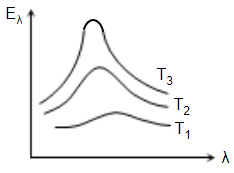A solid copper sphere (density and specific heat capacity c) of radius r at an initial temperature 200K is suspended inside a chamber whose walls are at almost 0K. The time required (in s) for the temperature of the sphere to drop to 100 K is
(1)
(2)
(3)
(4)
(1)
One end of a copper rod of uniform cross-section and of length 3.1 m is kept in contact with ice, and the other end with water at \(100^{\circ}\mathrm{C}\). At what point along its length should a temperature of \(200^{\circ}\mathrm{C}\) be maintained so that in steady-state, the mass of ice melting be equal to that of the steam produced in the same interval time? (Assume that the whole system is insulated from the surroundings. Latent heat of fusion of ice and vaporisation of water are 80 cal/gm and 540 cal/gm respectively)
| 1. | 21.3 cm from \(100^{\circ}\mathrm{C}\) end |
| 2. | 40 cm from \(0^{\circ}\mathrm{C}\) end |
| 3. | 125 cm from \(100^{\circ}\mathrm{C}\) end |
| 4. | 125 cm from \(0^{\circ}\mathrm{C}\) end |
A sphere and a cube of same material and same volume are heated upto same temperature and allowed to cool in the same surroundings. The ratio of the amounts of radiations emitted will be
(1) 1 : 1
(2)
(3)
(4)
The temperature of the two outer surfaces of a composite slab, consisting of two materials having coefficients of thermal conductivity K and 2K and thickness x and 4x, respectively are and ( > ). The rate of heat transfer through the slab, in a steady state is , with f which equals to -
(a) 1
(b)
(c)
(d)

1. \(\frac{r_1r_2}{r_1-r_2}\)
2. \(r_1-r_2\)
3. \(({r_1-r_2})({r_1r_2})\)
4. \(\mathrm{ln}\frac{r_2}{r_1}\)
The graph shown in the adjacent diagram, represents the variation of temperature (T) of two bodies, x and y having same surface area, with time (t) due to the emission of radiation. Find the correct relation between the emissivity (e) and absorptivity (a) of the two bodies .
(1)
(2)
(3)
(4)
The plots of intensity versus wavelength for three black bodies at temperatures \(T_1, T_2 ~\text{and}~T_3\) respectively are as shown. Their temperature are such that:
1. \(T_1>T_2>T_3\)
2. \(T_1>T_3>T_2\)
3. \(T_2>T_3>T_1\)
4. \(T_3>T_2>T_1\)
The adjoining diagram shows the spectral energy density distribution \(E_{\lambda}\) of a black body at two different temperatures. If the areas under the curves are in the ratio \(16:1,\) the value of temperature \(T\) is:

1. \(32000~\text K\)
2. \(16000~\text K\)
3. \(8000~\text K\)
4. \(4000~\text K\)
Following graph shows the correct variation in intensity of heat radiations by black body and frequency at a fixed temperature
Variation of radiant energy emitted by sun, filament of tungsten lamp and welding arc as a function of its wavelength is shown in figure. Which of the following option is the correct match?

(1) Sun-, tungsten filament- welding arc -
(2) Sun-, tungsten filament-, welding arc-
(3) Sun-, tungsten filament- welding arc-
(4) Sun-, tungsten filament-, welding arc-











